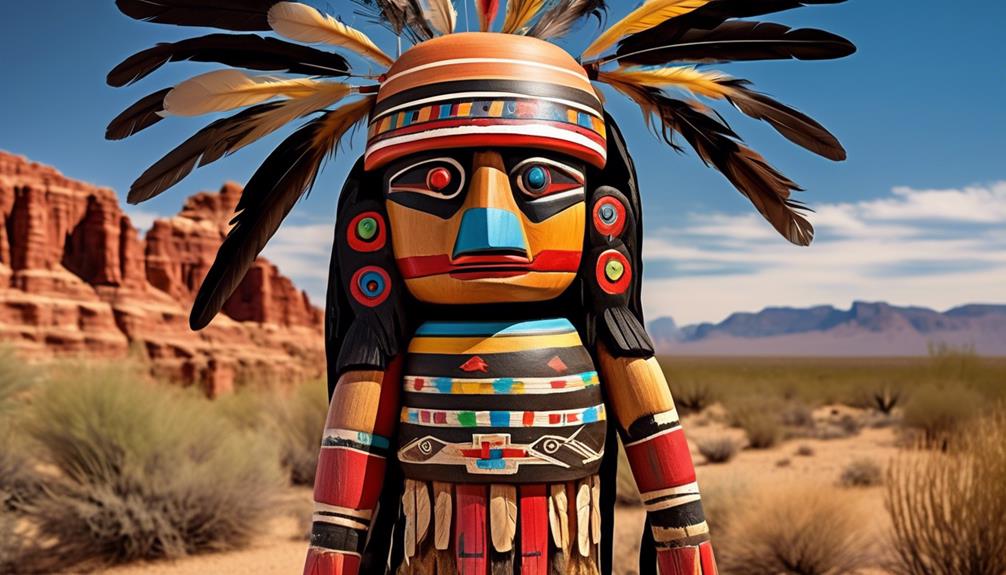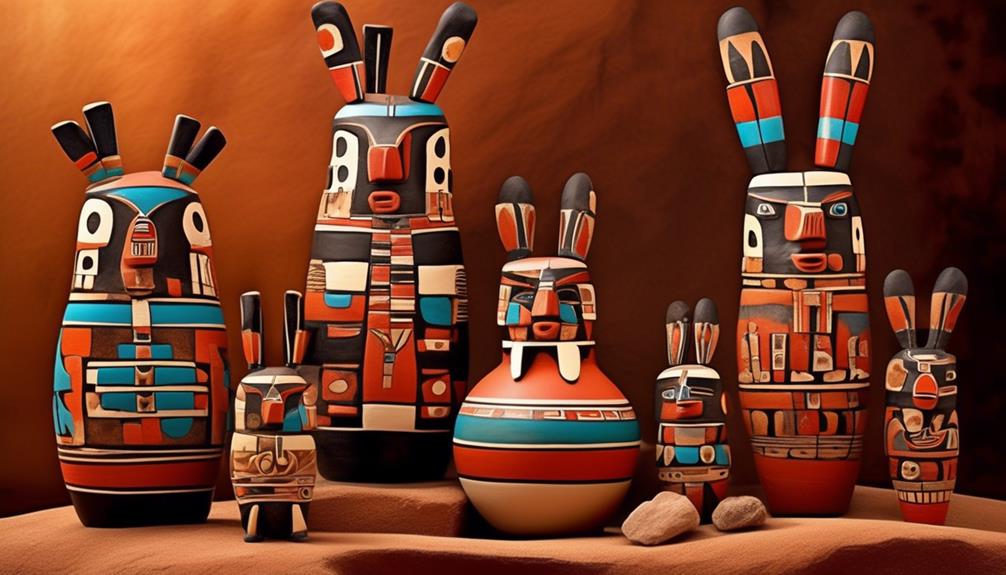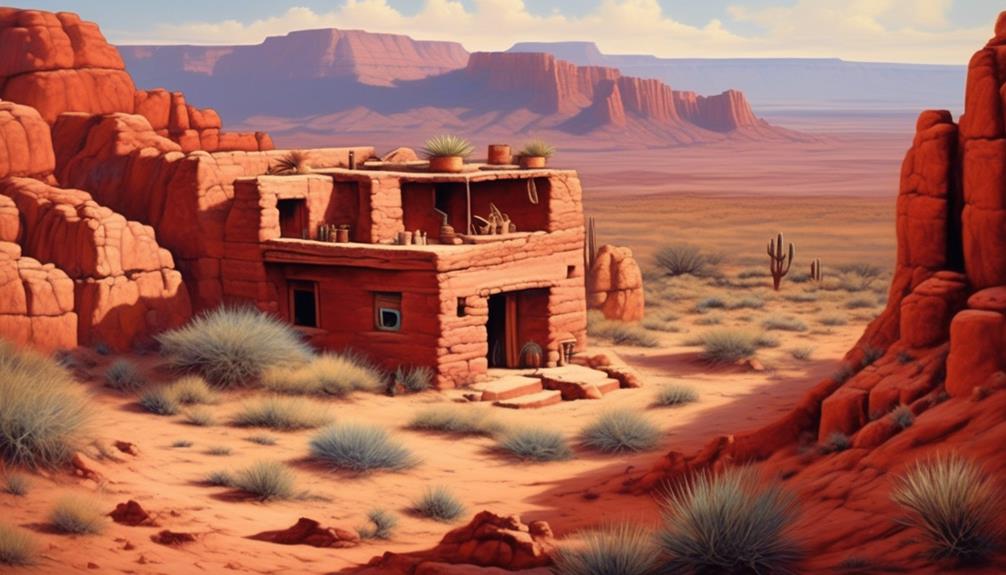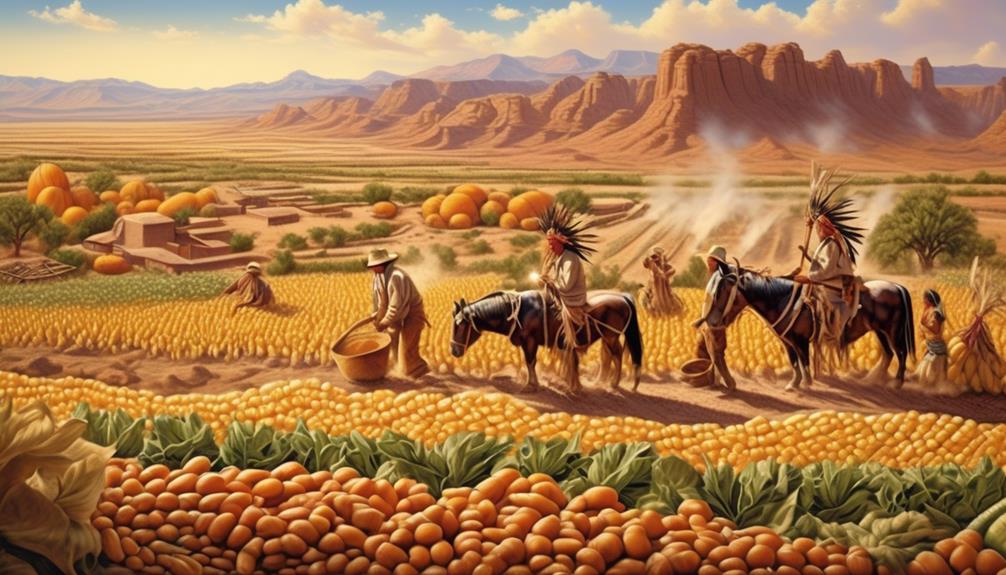The Hopi tribe was recognized for their deep spiritual bond with the earth. They possessed a thorough comprehension of the interdependence of all living beings and emphasized the significance of preserving harmony with the environment. This spiritual connection impacted their everyday choices and shaped their lifestyle.
In addition to their spiritual practices, the Hopi people were also highly skilled in pottery and basket weaving. They used these traditional crafts not only for practical purposes but also as a form of artistic expression. Their pottery was known for its intricate designs and vibrant colors, while their baskets displayed expert craftsmanship and attention to detail.
Another notable aspect of Hopi culture is the creation of Kachina dolls. These dolls, made out of cottonwood root, were not mere toys but embodied the spirits of various deities and ancestors. Each doll was intricately carved and painted with meticulous detail, representing different aspects of Hopi mythology and cosmology.
The Hopi tribe also practiced sustainable agricultural practices. They carefully cultivated their crops, utilizing techniques such as terracing and crop rotation to ensure the long-term health of the soil. They understood the importance of preserving resources for future generations and were stewards of the land.
Above all, the Hopi people held a deep reverence for the Earth. They saw themselves as caretakers of the land and believed in the sacredness of all living things. This reverence extended to their daily lives, where they made conscious choices to live in harmony with nature and minimize their impact on the environment.
The legacy of the Hopi tribe encompasses not only their artistic and cultural contributions but also their profound spiritual connection to the land, sustainable agricultural practices, and their deep reverence for the Earth. Their way of life serves as a powerful reminder of the importance of living in harmony with nature and preserving our planet for future generations.
Key Takeaways
- The Hopi tribe is known for their spiritual connection to the land, demonstrated through land rituals, nature ceremonies, and a reverence for the earth.
- They are skilled in pottery and basket weaving, utilizing traditional techniques and incorporating spiritual motifs, geometric patterns, and symbolic imagery.
- The Hopi tribe is renowned for their vibrant Kachina dolls, which play a vital role in ceremonies and rituals, and are powerful embodiments of Hopi culture.
- They practice sustainable agricultural practices, including crop rotation, water conservation, seed saving, terracing, and companion planting, to maintain ecological balance and preserve indigenous plant varieties.
Spiritual Connection to the Land
The Hopi people's spiritual connection to the land is deeply rooted in their traditions, shaping their daily lives and guiding their cultural practices. Land rituals and nature ceremonies are integral to the Hopi way of life, illustrating their profound respect for the natural world. These rituals aren't merely symbolic; they're active demonstrations of the Hopi people's reverence for the earth and its resources.
As observers, one can witness the intricate dances and songs performed during these ceremonies, expressing gratitude for the land's bountiful provisions. Comparatively, these rituals serve as a stark contrast to modern society's often exploitative relationship with the environment. The Hopi people's ceremonies highlight the interconnectedness of all living beings with the land, emphasizing the importance of sustainability and harmony.
Contextually, these traditions have endured for centuries, preserving the Hopi people's spiritual bond with the land despite external influences. These ceremonies continue to be a vital part of the Hopi culture, serving as a reminder of the enduring significance of their spiritual connection to the land.
Skillful Pottery and Basket Weaving
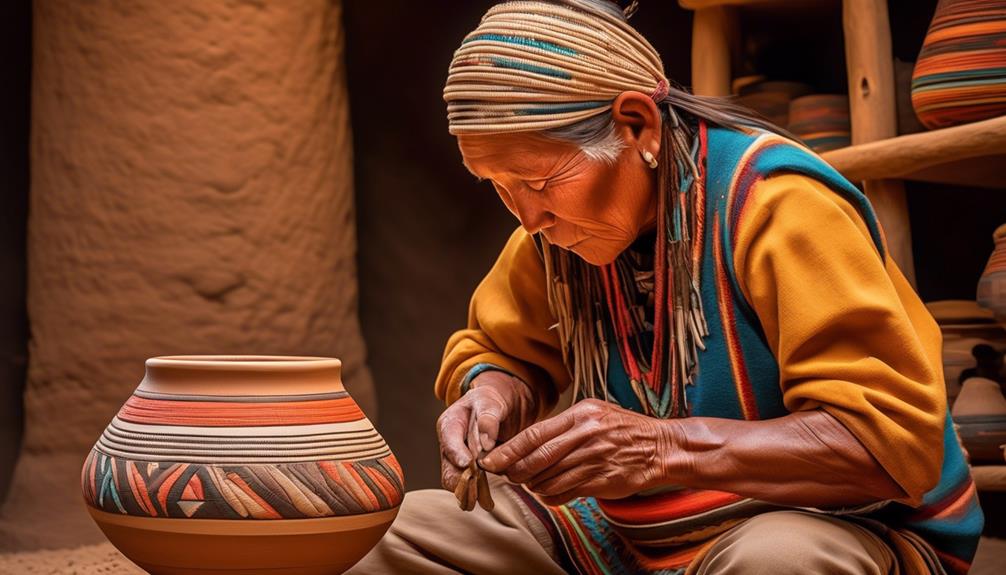
Observing the Hopi people's deep spiritual connection to the land, their skillful pottery and basket weaving traditions reflect a harmonious integration of artistry and reverence for nature. The Hopi tribe's pottery techniques and weaving traditions are deeply rooted in their cultural and spiritual beliefs, showcasing an unparalleled level of craftsmanship and attention to detail. The pottery created by the Hopi people is known for its intricate designs and symbolic representations of their connection to the natural world. Similarly, their basket weaving traditions incorporate sustainable harvesting practices and a profound understanding of local plant materials.
| Pottery Techniques | Weaving Traditions |
|---|---|
| Utilize coil and scrape methods | Utilize natural fibers such as yucca and rabbitbrush |
| Designs often depict spiritual motifs | Designs often incorporate geometric patterns and symbolic imagery |
| Firing process involves traditional outdoor kilns | Harvesting of materials is done with respect for ecological balance |
The Hopi people's pottery techniques and weaving traditions not only serve as a testament to their artistic abilities but also stand as a reflection of their deep connection to the land and the timeless wisdom passed down through generations.
Vibrant Kachina Dolls
Admiring the vibrant Kachina dolls crafted by the Hopi tribe, one can't help but marvel at the intricate details and vivid colors that bring these ceremonial figures to life. These dolls hold a special place in the Hopi culture, representing a blend of traditional craftsmanship, symbolism, cultural significance, and artistic expression.
- Traditional Craftsmanship: The Kachina dolls are meticulously handcrafted by skilled artisans, showcasing the Hopi tribe's dedication to preserving traditional techniques and passing down their craftsmanship through generations.
- Symbolism: Each Kachina doll embodies deep spiritual and symbolic meanings, often representing deities, spirits, or ancestors. The intricate designs and adornments on the dolls convey rich narratives and beliefs within the Hopi tradition.
- Cultural Significance: These dolls play a vital role in Hopi ceremonies and rituals, symbolizing the presence of ancestral spirits and serving as messengers between the human and spiritual realms.
- Artistic Expression: The vibrant colors, intricate patterns, and diverse styles of Kachina dolls reflect the artistic creativity and individuality of the Hopi artisans, showcasing their ability to infuse life and personality into each figure.
The vibrant Kachina dolls stand as powerful embodiments of Hopi culture, encapsulating the tribe's deep-rooted traditions and artistic prowess.
Sustainable Agricultural Practices

With a deep reverence for our ancestral wisdom and a commitment to preserving our lands, the Hopi tribe has cultivated sustainable agricultural practices that sustain both our community and the environment. Our sustainable farming techniques are deeply rooted in traditional agriculture methods, reflecting our profound respect for the earth and its resources. Through generations, we have honed these practices to work in harmony with nature, ensuring the longevity of our crops and the well-being of our people.
| Sustainable Agricultural Practices | ||
|---|---|---|
| Crop Rotation | Water Conservation | Seed Saving |
| By rotating crops, we maintain soil fertility and prevent pest infestations. | We utilize irrigation techniques that minimize water usage, preserving this precious resource. | Saving and exchanging seeds ensures the preservation of indigenous plant varieties. |
| Terracing | Companion Planting | Organic Fertilization |
| Terracing minimizes erosion, making the most of arable land in our mountainous terrain. | Companion planting maximizes crop yield and deters pests without the need for harmful chemicals. | Using organic materials such as compost and animal manure enriches the soil naturally. |
Our sustainable agricultural practices not only yield nourishing produce but also safeguard the delicate balance of our ecosystem, embodying the harmony we strive to maintain with our natural surroundings.
Reverence for the Earth
How can we honor and preserve the Earth's gifts while continuing to thrive as a community? The Hopi Tribe exemplifies environmental stewardship through their deep connection to the land and a commitment to maintaining ecological balance. Their reverence for the Earth is ingrained in their traditions, shaping their way of life and inspiring a profound respect for nature.
- Traditional Ceremonies: The Hopi Tribe's traditional ceremonies are intricately linked to the Earth, emphasizing gratitude and harmony with the natural world.
- Intergenerational Wisdom: The transmission of ecological knowledge from elders to younger generations ensures the preservation of sustainable practices and a profound understanding of the interconnectedness of all living beings.
- Sacred Land: The Hopi people view the Earth as sacred, fostering a sense of responsibility for its preservation and a deep understanding of the consequences of environmental degradation.
- Harmonious Coexistence: Their reverence for the Earth promotes a balanced coexistence with nature, influencing their agricultural practices, resource management, and overall lifestyle.
The Hopi Tribe's reverence for the Earth serves as a poignant reminder of the importance of maintaining a harmonious relationship with the environment, offering valuable insights for sustainable living and ecological preservation.
Frequently Asked Questions
What Is the History of the Hopi Tribe's Interactions With Other Native American Tribes?
We've observed that the Hopi Tribe's intertribal relations were characterized by cultural exchanges. Their interactions with other Native American tribes were marked by trade, alliances, and shared religious ceremonies.
The Hopi Tribe often engaged in peaceful exchanges, fostering strong connections with neighboring tribes. These interactions played a significant role in shaping the cultural landscape of the region, as they allowed for the exchange of traditions, beliefs, and practices among different tribes.
How Has the Hopi Tribe's Traditional Clothing and Jewelry Evolved Over Time?
Over time, the evolution of fashion among the Hopi tribe has been fascinating.
The cultural adornments, like traditional clothing and jewelry, have undergone significant changes.
The evolution of fashion reflects the tribe's history, values, and artistic expression.
From intricate beadwork to vibrant fabric patterns, the evolution of these cultural adornments showcases the Hopi tribe's rich heritage and creativity.
The transformation of traditional clothing and jewelry over time is a testament to the tribe's enduring cultural identity.
What Are Some Common Myths and Legends From Hopi Culture?
Hopi legends play a central role in their spiritual beliefs and cultural significance. The tribe's storytelling traditions are deeply rooted in their traditional ceremonies, reflecting the social structure. These myths and legends are passed down through generations, shaping the Hopi's worldview.
They offer insights into their history, values, and relationship with the land. The stories often revolve around the natural world, deities, and ancestral heroes, illustrating the tribe's rich oral tradition.
How Has Modern Technology Impacted the Traditional Way of Life for the Hopi Tribe?
Modern technology has had a significant impact on the traditional way of life for the Hopi tribe. The influence of globalization has brought changes in communication, transportation, and access to information.
While these advancements have provided new opportunities, they also present challenges in preserving our cultural traditions.
As we navigate this intersection of old and new, we strive to find a balance that allows us to embrace modernity while safeguarding our heritage.
What Are Some Important Annual Ceremonies and Rituals Practiced by the Hopi Tribe?
So, the Hopi tribe is big on their annual ceremonies and religious rituals. These practices are deeply rooted in their cultural traditions, from traditional dances to storytelling and artistic expressions. They hold strong spiritual beliefs and maintain their agricultural traditions.
It's quite fascinating how they've preserved these customs over time. It's like stepping into a living museum of ancient traditions and beliefs.
Conclusion
As we reflect on the Hopi tribe, we're struck by their deep spiritual connection to the land, demonstrated through their skillful pottery and basket weaving.
The vibrant Kachina dolls and sustainable agricultural practices further showcase their reverence for the earth.
It's a reminder of the importance of preserving traditions and living in harmony with nature, a lesson that continues to resonate in our modern world.
